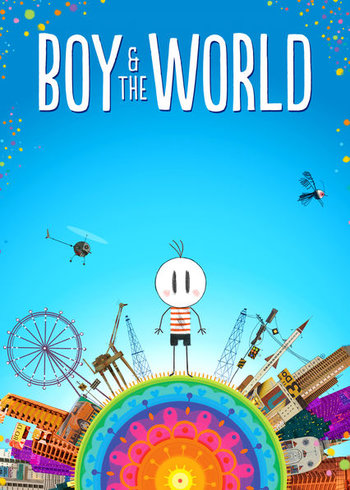
Boy & the World (O Menino e o Mundo) is a 2013 Brazilian animated film directed by Alê Abreu. The film follows the adventures of a boy, Cuca, exploring the world. It was a 2015 Oscar nominee for Best Animated Feature. It explores childhood innocence, Fascism, war between artistic civilians and a totalitarian regime, and just how beautiful and emotional an animated feature can be. It was released in the USA by GKIDS.
This film provides examples of:
- Absurdly Long Stairway: In the city, Cuca and his rainbow hat man friend walk up many long stairways by necessity, the houses are built in such a way that buildings on top of each other create sloping mountains. It is the first time we see Cuca visibly exhausted. Thankfully the Rainbow Hat Man carries him the rest of the way to his home.
- All There in the Manual: Cuca’s name is never actually said in the movie due to everyone Speaking Simlish. It’s only mentioned in the making-of documentary on the DVD.
- Ambiguous Ending: It’s unclear whether the final scene was Cuca remembering his childhood, dying and joining his parents in the afterlife, or simply the film returning to the “past as present” narrative style.
- ...And That Little Boy Was Me: The final two scenes reveal that both the teenaged Rainbow Hat Man and the elderly Harvester are actually Cuca at different times in his life (when he arrived in the city to look for his father, and after he went back to the countryside post-rebellion). The Cuca we were following is the representation of him reminiscing through a more child-like lens.
- Chekhov's Gun: Cuca capturing the music bubble, the colorful musical parade, the bird motifs— all come together in the climax to represent the elements of the rebellion.
- Design Student's Orgasm: In contrast with the strikingly minimalist portions of the film, the defined environments use more striking styles, such as collages and crayon-esque scribbles in order to make it more deliberate.
- Downer Ending: An older, much more tired Cuca (the Harvester) returns to his home in the countryside after he has apparently been a part of a failed rebellion, and fired from his job at the plantation due to his age. The ambiguity of the situation grows after he's done reminiscing, but it's implied he passes away.
- Hope Spot: Cuca finally catches up with the train that took his father away, and it looks like his dad is getting off...but then the other train-riders appear, and they are all identical copies of each other, right down to the flute in their front shirt pocket.
- Incurable Cough of Death: The harvester that Cuca befriends has one of these that he attempts to suppress. he tries his best, but when the plantations owner/inspector comes to inspect the workers, the Harvester cannot hold his breath and lets loose a pretty bad coughing fit, which the Inspector sends him home for. It's implied that its not necessarily a cold or disease, but the strain of the work itself that causes this cough.
- Leitmotif: The melodies played by the bird-masked musician and the government's brass melody. Out of the two, the more prominent is the bird-mans flute, which is built upon with drums, chanting lyrics and horns in order to associate it with the parade of rebels.
- Parental Bonus: Many of the scenes of Cuca in the city evoke this, as he is exposed to many non-child friendly things, including bars and prostitution. Interestingly, all of these scenes are directed so that the implications will likely go over child viewers' heads.
- The Reveal: Cuca, and the two main friends he made during his travels are all the same person remembering his past. The nostalgic color of the rebels and the reality of that confrontation is laid bare in the climax, where the rebels are very much poverty stricken and the Young Cuca gets caught in the crossfire of the conflict.
- Scenery Porn: The entire film. For all the instances empty space is being used, there's a very well put together shot of a city that's built upon itself and full of staircases, or a vast grass field that Cuca's mother is painting.
- Scenery Gorn: on the opposing side, the city is a collage of buildings and billboards, where from Cuca's perspective, the machines look like strange metal beasts of different sorts.
- Speaking Simlish: The dialogue and visible signage is gibberish, both to emphasize the childlike view of the world and to avoid putting the story in a particular location.
 Word of God is that the language is just backwards Portuguese.
Word of God is that the language is just backwards Portuguese.
